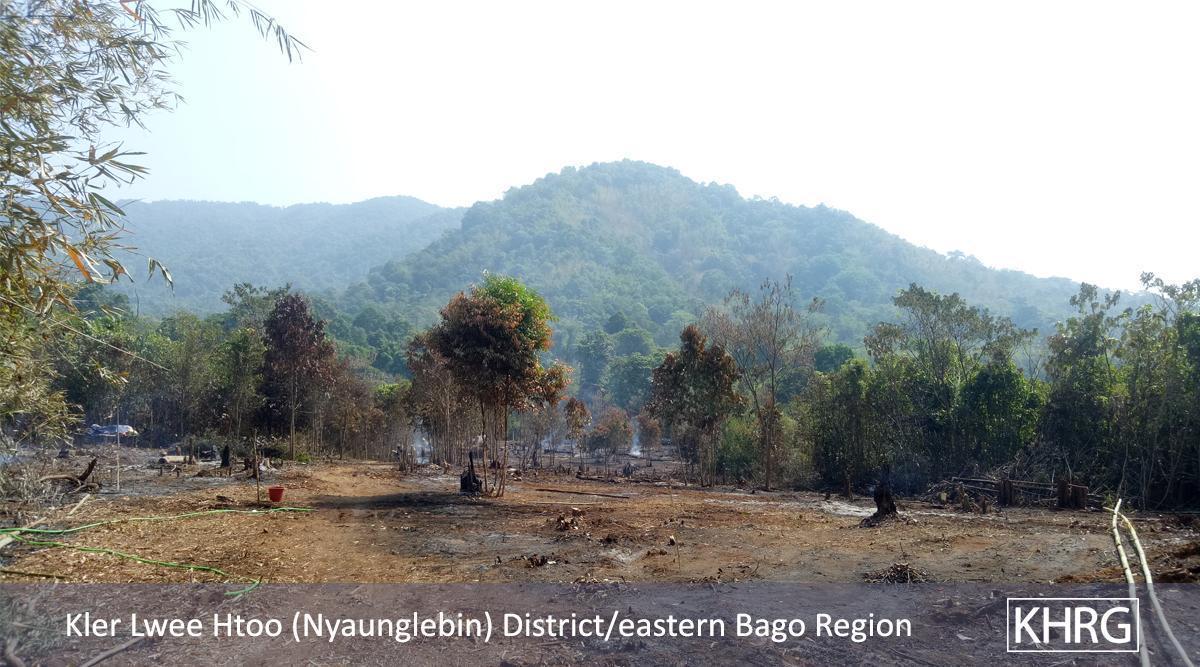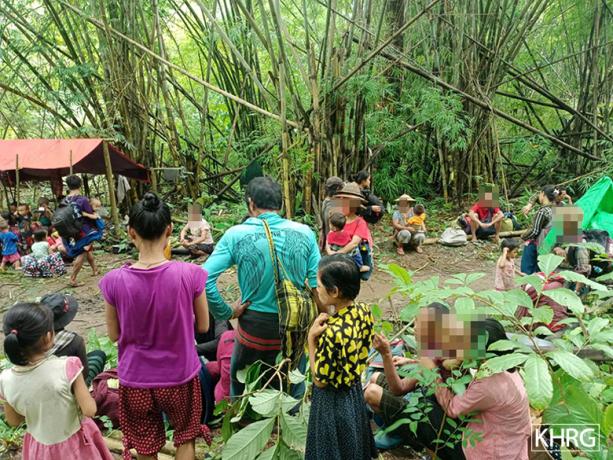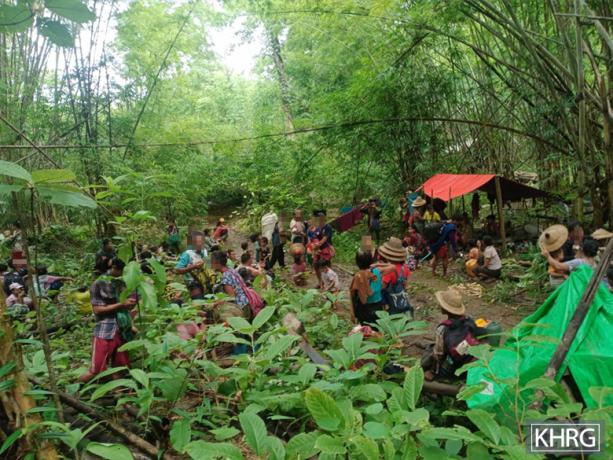This Situation Update describes events that occurred in Moo (Mone) Township, Kler Lwee Htoo (Nyaunglebin) District between June and July 2022. It includes information regarding armed clashes, displacement, food insecurity, and health care. On July 2nd 2022, fighting broke out between Karen National Liberation Army (KNLA) and State Administration Council (SAC) troops in Moo Township. The indiscriminate shelling of mortars by the SAC resulted in the displacement of villagers in multiple village tracts. The displaced villagers were concerned that they would face further food shortages if the fighting continued for an extended period of time. Some displaced villagers suffered from colds, coughs, runny noses, and fevers because they were unable to access medical care.[1]
Introduction
Between June 21st and July 5th 2022, fighting broke out in Paw Pee Der village tract[2], Thawaw T’Ku village tract, T’Hkaw Pwa village tract, and Noh Nyah Lah village tract, Moo (Mone) Township, Kler Lwee Htoo (Nyaunglebin) District. Due to fighting and shelling, local villagers were forced to flee, and faced food insecurity and health issues.
Displacement
On July 2nd 2022, fighting broke out between Karen National Liberation Army (KNLA)[3] and State Administration Council (SAC)[4] troops without any warning [taking the villagers by surprise] in H--- village and P--- village, Paw Pee Der village tract, A---village, T’Hkaw Pwa village tract, and K--- village, Thawaw T’Ku village tract, Moo Township, Kler Lwee Htoo District. [On July 2nd and the following days,] SAC soldiers from Light Infantry Battalion (LIB)[5] #590 shelled mortars at H--- village, Paw Pee Der village tract, causing some of the villagers to flee to Pyuh Town and N--- village, Thawaw T’Ku village tract. Since the villagers had to flee immediately, they were unable to bring clothes, medicine, or food with them. At first, the villagers thought that the fighting would only last a short period of time. However, after the fighting broke out between SAC and KNLA soldiers, SAC soldiers entered H--- village and fired mortars into the village, making displaced villagers too afraid to return. Some of the villagers stayed at Pyuh Town and N--- village.
Food insecurity and displacement difficulties
On July 2nd 2022, because of the armed conflict, villagers from from H--- village in Paw Pee Der village tract, T--- village and A--- village in T’Hkaw Pwa village tract, N--- village, S---village, W--- village, and P--- village in Noh Nyga Lah village tract, R--- village in Thawaw T'Ku village tract, and W---village in Wai Shwen village tract, fled to N---village, Thawaw T’Ku village tract. There, they faced problems of food shortages. They were unable to take the food from their village because the Burmese military [SAC] lived in it [occupied it]. The displaced villagers were worried that if they returned to their villages, they would be arrested, hit, and tortured, so they were too afraid to return to their villages to get food. As a result, they had to borrow food from N--- villagers. However, N--- villagers also previously had to displace [due to armed clashes in the area], so they didn’t have enough food [for everyone]. If fighting continued for a long time, they were afraid they would face further problems of food shortages.
The village administrator asked the villagers who fled to N---village to move and seek refuge in the jungle [after they stayed in the village for a while] because they were worried that Burmese [SAC] soldiers would come to the village. The displaced villagers stayed in the jungle, which is far away from the village, and they didn’t have enough food [faced food insecurity]. Additionally, the displaced villagers faced serious problems when it was raining because some didn’t have roofs [tarpaulins], and those who had roofs [tarpaulins] only had old and torn ones. [As of March 2023, villagers who fled to N--- village have not yet returned to their villages].
Health care
Villagers in Thawaw T’Ku village tract, Paw Pee Der village tract, T'Hkaw Pwa village tract and Noh Nyah Lah village tract, Moo Township, were forced to flee and some stayed in the jungle without access to medical care. Children, pregnant women, newborn mothers, the elderly, and those with medical conditions were among the displaced villagers; as a result, their long journey presented challenges. Some children developed fevers, coughs, runny noses, and colds, and all reported feeling exhausted. They faced health difficulties as a result of insect bites. Since they only had one set of clothes with them, some of the displaced villagers struggled to take a bath. Their clothing became soaked because it was often raining, and it was challenging to dry them. As a result, some people got colds and runny noses. It was difficult for mothers and their newborns to deal with the cold situation. Some women had just delivered their babies a few days prior. They faced health challenges because they didn’t have enough food and medicine.
Further background reading on the security and human rights situation in Kler Lwee Htoo District in Southeast Burma can be found in the following KHRG reports:
- “Kler Lwee Htoo District Short Update: Fighting, indiscriminate shelling, displacement, air strikes, and limited access to education, August to September 2022”, March 2023.
- “Kler Lwee Htoo District Incident Report: SAC arbitrarily killing of a villager near his farm hut, Moo Township, September 2022”, February 2023.
- “Kler Lwee Htoo District Incident Report: SAC soldiers shot dead a female villager in Moo Township, November 2022”, February 2023.
- “Kler Lwee Htoo District Short Update: Fighting and displacement, air strikes and SAC indiscriminate shelling, July to September 2022”, February 2023.
Footnotes:
[1] The present document is based on information received in July 2022. It was provided by a community member in Kler Lwee Htoo District who has been trained by KHRG to monitor human rights conditions on the ground. The names of the victims, their photos and the exact locations are censored for security reasons. The parts in square brackets are explanations added by KHRG.
[2] A village tract is an administrative unit of between five and 20 villages in a local area, often centred on a large village.
[3] The Karen National Liberation Army is the armed wing of the Karen National Union.
[4] The State Administration Council (SAC) is the executive governing body created in the aftermath of the February 1st 2021 military coup. It was established by Senior General Min Aung Hlaing on February 2nd 2021, and is composed of eight military officers and eight civilians. The chairperson serves as the de facto head of government of Burma/Myanmar and leads the Military Cabinet of Myanmar, the executive branch of the government. Min Aung Hlaing assumed the role of SAC chairperson following the coup.
[5] A Light Infantry Battalion (LIB) comprises 500 soldiers. Most Light Infantry Battalions in the Tatmadaw are under-strength with less than 200 soldiers, yet up-to-date information regarding the size of battalions is hard to come by, particularly following the signing of the NCA. LIBs are primarily used for offensive operations, but they are sometimes used for garrison duties.






